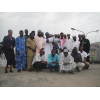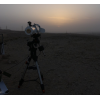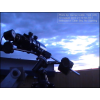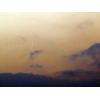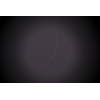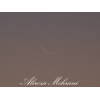Visibility of Ramadan Crescent 1431 AH
- When to Observe Ramadan Waxing (NEW) Crescent ?
- Ramadan Waxing (NEW) Crescent Observation Results
- The OFFICIAL First Day in Different Countries
- When to Observe Sha'ban Waning (OLD) Crescent ?
- Sha'ban Waning (OLD) Crescent Observation Results
- ICOP Ramadan Official Statement
When to Observe Ramadan Waxing (NEW) Crescent ?
The geocentric conjunction (Geocentric New Moon) will occur Inshalla on (Tuesday 10 August 2010) at 03:08 UT.
Sighting the new crescent on (Tuesday 10 August 2010) and (Wednesday 11 August 2010) is shown in the below graphs using the program Accurate Times by Mohammad Odeh according to Odeh criterion. Where:-
- It is impossible to see the crescent from the areas located under the red color. Because either the Moon on this day sets before the Sunset and/or the topocentric conjunction occurs after the Sunset.
- The crescent is expected to be seen by optical aid only from the areas located under the blue color.
- The crescent is expected to be seen by optical aid from the areas located under the magenta color. In these areas the crescent could be seen by naked eye if the atmospheric conditions are superb and the observer is experienced.
- The crescent is expected to be easily visible by naked eye from the areas located under the green color.
- The crescent cannot be seen from uncolored areas, even though the Moon sets in these locations after the Sunset and the topocentric conjunction occurs before the Sunset, but the Moon is not sufficiently illuminated in order to be seen as crescent even by optical aid.
- Kindly notice that the below graph shows the possibility of seeing the crescent from areas between 60 degrees north of Equator down to 60 degrees south of Equator.
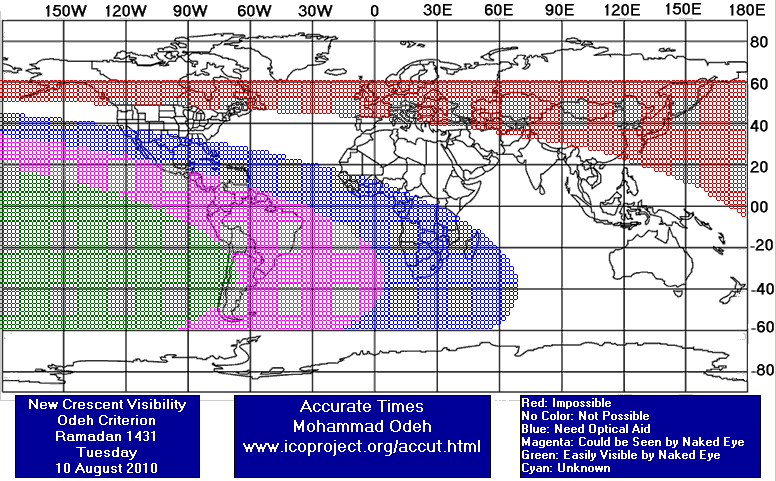
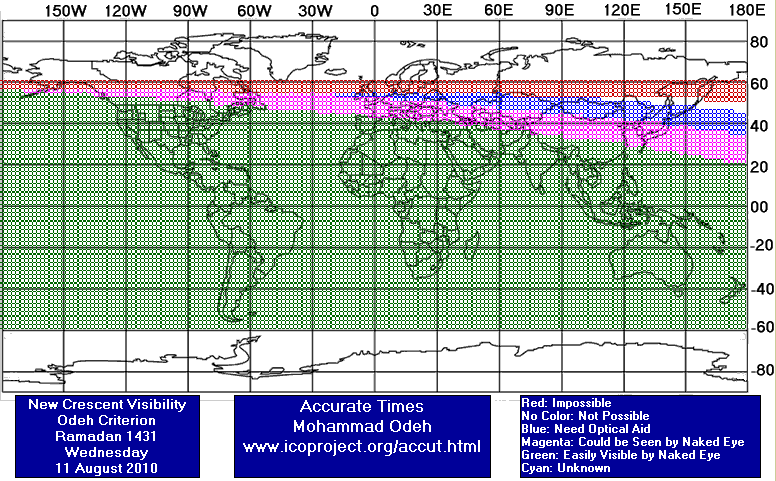
According to the Universal Hejric Calendar (UHC), which is based on the calculated crescent visibility, the start of this month in the Eastern Region will be on Wednesday 11 August 2010 and in the Western Region will be on Wednesday 11 August 2010. Kindly notice that the UHC is a pre-calculated calendar, which adopts a certain criterion to start the new Hejric month. Your country/organization might adopt different criterion to start the new Hejric month. So it is highly advised to read the UHC website before giving any judgment.
- Results of seeing the crescent, and the first day of the month in different countries will be added here Inshalla as we receive the reports from ICOP's members. If you wish to be a member in ICOP, or to know more about it, kindly click here.
Ramadan Waxing (NEW) Crescent Observation Results
Tue 10 August 2010
Algeria
Mr. Hocine Chikh Aissa said: "19 people have tried to observe, with naked eye and using 4 binoculars, the crescent of Ramadan 1431 but it wasn't seen. The western horizon was hazy and partly cloudy from ammi said n'tissa Station. TAKABALA ALLAHO SIYAMA WA LKIYAM. "
Indonesia
Mr. AR Sugeng Riyadi said: "Indonesian Government in this case the Ministry of Religious Affairs announced the beginning of a Ramadhan 1431 AH after confirmation hearing. Confirmation hearing that was held at the Ministry of Religious Affairs Building, Jakarta, Tuesday (10/08/2010) was attended by attended by the Head of Fatwa Council of Ulama Indonesia (MUI) Ma'ruf Amin, representatives of mass-Islamic oramas, several representatives of ambassadors from friendly countries, in antarnya Saudi Arabia, Jordan, and Palestine. Religious Affairs Minister Suryadharma Ali said, to make observations Hilal held in 10 places involving expert astronomers. In addition, in some areas along rukyat Ministry Religion fulfilling their local religious courts, Islamic organizations, community leaders and others. The Chairman further explained Hisab Rukyat Ministry of Religious Affairs (BHR) Abdul Rohadi the conjuction before mentioning the results of first day of Ramadan falls on Tuesday, August 10th at approximately 10:09 am. The position of the new moon was 1 degrees 14 minutes to 2 degrees more. "So first of Ramadhan falls on a Wednesday," explained Rohadi. Determining the beginning of Ramadhan is also in accordance with the determination in some neighboring countries, intimation Muhamadiyah, NU almanac, Al-Ershad, Persis, and Almanac of the Minaret. Rohadi added, until now rukyat report obtained at two places ie at Porbolingo and Gresik, where the moon can be seen."
Iran
Jordan
Ms. Basma Dhiab said: " There were 6 committees responsible for observing the Helal in different areas in Jordan. One of them was in Marj Al hamam (west of Amman the capital city)where I were there with nearly 100 participants including some members of the Jordanian Astronomical Society (JAS) and some families who came from here and there. We used 3 binoculars and two telescopes one of them is 10 inch Schmidt Cassegrain but the crescent wasn't seen. The weather and the sky were very good so we made a stargazing night and had some observation activities (Venus,Saturn and the constellations) with help pf the lazer pointer. Our guests were happy alhamdolellah. After we finished many of them went for Taraweeh since the official announcement here in Jordan decided that the beginning of Ramadan is on Wen. 11 August. "
Lebanon
Libya
Malaysia
Mr. Kassim Bahali said: "Members of moon sighting committees with the leaders of Melaka state government and more than 400 people tried to sight the hilal at Al-Khawarizmi Astronomy centre in Tanjung Bidara, Melaka but the hilal was not sighted. The western sky was cloudy. The government was announced officially that Wednesday 11 August 2010 is 1st Ramadhan 1431 in Malaysia. "
Nigeria
Mr. Abdul-Rasaq Abdul-Azeez Ishola said: "I am happy to report for the first time in history All South west moonsighting Committee gathered in a Lagos searching for the Ramadan Crescent at Marina Leventis B/Stop Lagos State on the top of Pedestarian bridge searching for the moon with the distributed Telescope and Binocular given to us by The President of Nigeria Supreme Council of Islamic Affairs unfortunately the Crescent of 14hr 55min age was not seen due to Cloudness same report from Ilorin Kaduna and Iseyin.and we reported negative to the Chief Imam of Lagosand Chairman of National moonsighting Committe all of negative. later on Sulton Announced the sighting of the Moon with the naked eyes from the 8-10 places of the Nothern Nigeria. we wonder what will be our fate on Sept 8 when age of moon will be 7hr 13 min. "
Mr. Qamarudeen Muhammad said: "Over 40 People were in attendance, Ustaz Abdur Razak Isholaa, Imam Majolagbe, Uztaz Dhikurrah Shafii, Uztaz Tirimidh, Mr Shuaib(Member of TMC, Nigeria), Shaikh Mayaleke, moonsighting Committee representative from Oyo, Oshun and many other notable scholars within Lagos were present. However due to overcast and other well know factors the new Hilal was NOT visible. Meanwhile report from, Bauchi, Ilorin, Kaduan and Abuja is negative as well. But I was there when chief Imaam of Lagos state called on Sultan of Sokoto in order to relay observation report from Lagos, after their conversation, we all informed that positive sighting had been confirmed from Borno and about four other places, hence official first day of Ramadan in Nigeria is Wednesday 11, August 2010"
Mr. Simwal Jibril said: "The western horizon was cloudy, we coulnt even see the Sun set."
Norway
Mr. Milad Ali Ershaghi said: "Moonset time was 8:55pm and sunset time was 9:29pm - so it was not astronomically possible to see the moon. I attempted to look for it anyhow, at about 9:45pm - but did not see the moon."
Eng. Imran Mushtaq said: "Norway have offically announced the first of Ramadan on Wednesday 11.8.2010. Islamic Council of Norway has officcaly announed, based on conditions given by Hijri calendar agreement, that Norway will start Ramadan inshaAllah on Wednesday 11/8/2010. Ramadan Mubarak. "
Oman
Eng. Martin Elsaesser said: "We used a special crescent obsveration telescope to try to sight the crescent despite clouds and strong haze. Despite our best efforts, starting about 90 minutes before sunset, we could not image the crescent through the dust and haze. The clouds near the horizon made things even worse. The combination of crescent-geometry and site conditions were simply to unfavorable. Only a high-altitude location could have offered a chance and even then probably not after sunset. "
Pakistan
Mr. Alam Sultan said: "Today (Tuesday, 10 August 2010) was 28th Shaban 1431 in Pakistan and the moon was so defective in whole Asia that there was no solid proof in the history of astronomy to sight such a moon even by a telescope, hence there was no need to try to sight the moon in Pakistan but in spite of this fact, just to increase the trust of common people in the Science of Moon-sighting and because the people were confused due to the 29th Shaban in Saudi Arab, I requested the people to sight the moon today. Resultantly, On my request, nearly 300 persons (members of the moon-sighting committees of our institute "JAMIA-TUR-RASHEED" + my friends + their companions) tried to sight the moon at nearly 60 places all over Pakistan but the moon could not be sighted, as it was astronomically expected tonight. It was almost cloudy today countrywide, due to monsoon season. There is worst flood of history in Pakistan greater than Sonami etc. Nearly 14 million persons are directly affected. Pray and help your Pakistani brothers. Note 1: My respected teachers and friends are this time in Madinah (Saudi Arabia). They tried to sight the moon by naked eyes but not sighted as it was expected astronomically. Sky was clear. Note 2: After some days, inshaallah, a detailed report of this observation in Urdu will be available at www.esnips.com/web/moonnewsofjamiaturrasheed."
Qatar
Saudi Arabia
Mr. Saleh Al-Saab said: "There were more than 25 persons in the site but none saw the crescent. the altitude was only ONE degree."
Senegal
South Africa
United Kingdom
Eng. Qamar Uddin said: "On Tuesday 10 August 2010 (29 Shaban 1431 AH) many people from throughout UK have attempted to sight the crescent moon (Hilal) of Ramadan after sunset. Some places were clear but none of the groups were able to sight Hilal. We have not received any reliable sighting news from countries from East of UK/Morocco either. But we have received negative sighting reports from South Africa, Oman, India, Pakistan etc. Therefore, the Ulama have decided that the month of Shaban 1431 AH will complete 30 days and the month of Ramadan 1431 AH will start from Thursday 12 August 2010 (which means the night of 26 Ramadan will be on Monday 6 September 2010), Insha-Allah. May Allah forgive our mistakes, accept our prayers and grant us Jannah in the blessed month of Ramadan (Ameen)."
United States
Dr. Javad Torabinejad said: "I arrived at the sighting location at 7:25 (sunset: 8:19 pm EDT) and started looking for the crescent in the expected location with the sun in the lower right. I continued looking for the moon on and off till the moonset (moonset: 8:32 pm EDT). The western horizon was partly cloudy and hazy."
Dr. John Caldwell said: "Although it was a good sky, a small storm cloud covered the area when the moon was down below 4 degrees, so the best chance of seeing it was blocked, so not a strong negative; mercury confirmed the altaz pointing system"
Wed 11 August 2010
Germany
Iran
Jordan
Ms. Basma Dhiab said: "ICOP member Mr. Marwan Shwaiki and a group consists of 5 members of the Jordanian Astronomical Society ( JAS )participated in this observation and had their breakfast after Sunset on Wednesday August 11 in "Abu Soos "west of Amman. The group used a telescope and the crescent was easily seen by binocular too. Then after 4 minutes they could see the Crescent by naked eye. Several persons who passed by chance,joined the observation activity and the breakfast meal too :-). It was the first day of Ramadan in Jordan."
Pakistan
Mr. Alam Sultan said: "Although I could not sight the moon myself at my observing spot due to haze and partially clouds but Alhamdolillah our other members easily sighted the moon in Karachi and in many parts of country, as it was expected tonight astronomically. I requested many persons (members of the moon-sighting committees of our institute "JAMIA-TUR-RASHEED" + my friends + their companions) all over Pakistan to sight the moon. Many hundred Persons easily sighted the moon in all 4 provinces at these places: Karachi (at 5 places), Battal, Tando-Allah-Yar, Raheem-yar-khan, Panjgor, Aasia-abad, Swabi, Hyderabad, Badeen, Ghotki. These places were clear or little cloudy. Many other members also tried to sight at other locations but could not succeed due to clouds. Note 1 : Chairman of central official moon sighting committee of Pakistan mufti Munee-bur-Rahman and other members of committee also sighted the moon themselves and they also received positive reports from many other locations, thus he officially announced that 1st Ramadhan 1431 will be on Thursday 12 August 2010 in Pakistan after finishing the 29 days of Shaban 1431. Note 2: After some days, inshaallah, a detailed report of this observation in Urdu will be available at www.esnips.com/web/moonnewsofjamiaturrasheed "
Saudi Arabia
Mr. Saleh Al-Saab said: "The crescent was seen few minutes before sunset by Telescope 10 Inches reflector and by binocular after sometime but not by naked eye. Ramadhan mobarak for all members."
United States
Dr. Javad Torabinejad said: "This evening (Wednesday, August 11, 2010), due to the presence of adverse weather conditions, no sighting was possible in Blacksburg, VA."
The OFFICIAL First Day in Different Countries
Wed 11 August 2010
1 . Algeria
2 . Bahrain
3 . Germany
4 . Indonesia
5 . Iraq
6 . Jordan
7 . Kuwait
8 . Lebanon
9 . Libya
10 . Malaysia
11 . Nigeria
12 . Norway
13 . Palestine
14 . Qatar
15 . Saudi Arabia
16 . South Korea
17 . Sudan
18 . Syria
19 . Tunisia
20 . Turkey
21 . United Arab Emirates
22 . United States
23 . Yemen
Thu 12 August 2010
1 . Bangladesh
2 . Ghana
3 . India
4 . Iran
5 . Mauritania
6 . Morocco
7 . Oman
8 . Pakistan
9 . Senegal
10 . South Africa
11 . Sri Lanka
12 . Tanzania
13 . United Kingdom
When to Observe Sha'ban Waning (OLD) Crescent ?
The geocentric conjunction (Geocentric New Moon) will occur Inshalla on (Tuesday 10 August 2010) at 03:08 UT.
Sighting the OLD crescent on (Tuesday 10 August 2010) and on (Monday 09 August 2010) is shown in the below graphs using the program Accurate Times by Mohammad Odeh according to Odeh criterion. Where:-
- It is impossible to see the OLD crescent from the areas located under the red color. Because either the Moon on this day rises after the Sunrise and/or the topocentric conjunction occurs before the Sunrise.
- The crescent is expected to be seen by optical aid only from the areas located under the blue color.
- The crescent is expected to be seen by optical aid from the areas located under the magenta color.. In these areas the crescent could be seen by naked eye if the atmospheric conditions are superb and the observer is experienced.
- The crescent is expected to be easily visible by naked eye from the areas located under the green color.
- The crescent cannot be seen from uncolored areas, even though the Moon rises in these locations before the Sunrise and the topocentric conjunction occurs after the Sunrise, but the Moon is not sufficiently illuminated in order to be seen as crescent even by optical aid.
- Kindly notice that the below graph shows the possibility of seeing the crescent from areas between 60 degrees north of Equator down to 60 degrees south of Equator.
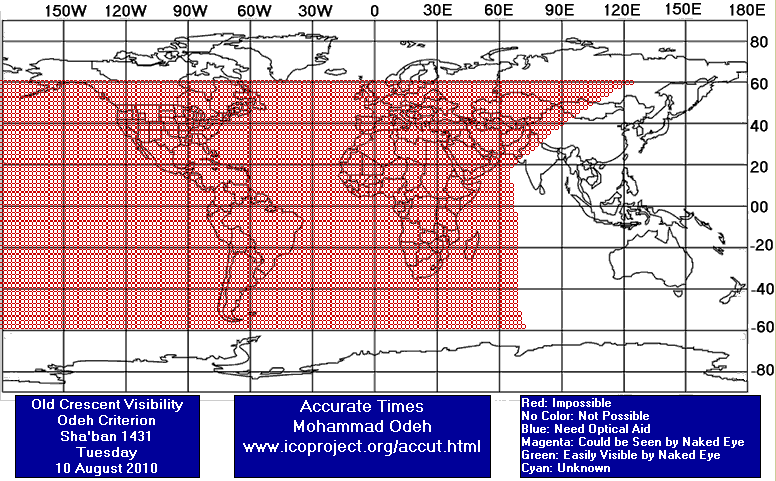
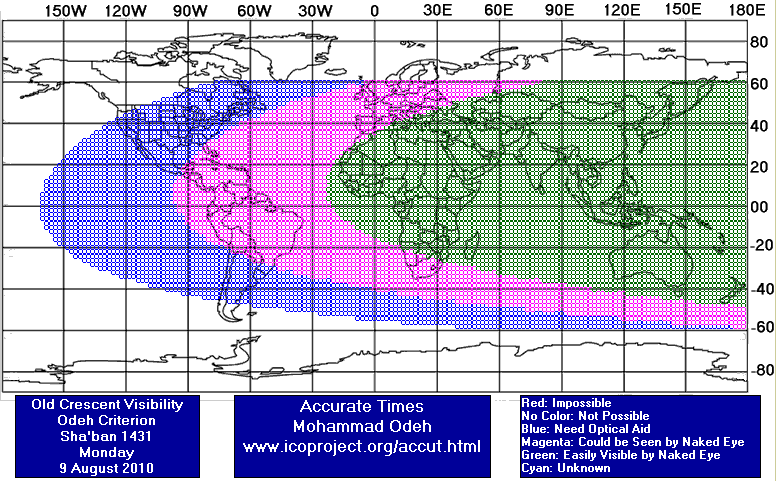
Sha'ban Waning (OLD) Crescent Observation Results
Mon 09 August 2010
Indonesia
Iran
Oman
Eng. Martin Elsaesser said: "From a hotel room in Muscat, facing east, the horizon was fully clouded and also a lot of haze in the sky. I could not detect any gap in the clouds there before sunrise, so i could not see the old crescent. Might try again during the day. Yesterdays crescent was simple and beautiful."
ICOP Ramadan Official Statement
Most Muslim countries started the month of Sha’ban on Tuesday July 13, so they will be looking for the new crescent of the month of Ramadan on August 10, even though it will not be possible to sight the crescent on that evening by naked eye or using by telescopes from anywhere in Asia, Europe, and most of Africa.
The crescent moon could be observed by telescopes in the southern and south-western regions of Africa and in Central and South America. Most importantly, it could only be seen by naked eye (on Aug. 10) in South America (see the map below). With these possibilities, we may expect some Muslim countries to start the month of Ramadan on Wednesday, August 11, 2010. However, countries which require the sighting of the crescent to be made from within their borders or regions can be expected to start the month of Ramadan on Thursday August 12.
Other Muslim countries, like Pakistan and the Morocco, started the month of Sha’ban on July 14th; they will be looking for the Ramadan crescent on the 11th of August and thus starting the month on Thursday August 12th, the crescent being easily visible on the evening of Aug. 11. The Islamic Crescents Observation Project (ICOP) is also happy to announce that a new technology for seeing/imaging the crescent moon was successfully used at the start of the month of Sha’ban, on Monday, July12. This new technology/method uses a telescope equipped with a special video camera, all controlled by a computer with a program which records and processes the hundreds of images taken. This technology then allows us to image a crescent that would be practically impossible to see using the traditional methods, i.e. naked eyes or “normal” telescopes.
ICOP experts used this method to observe the crescent moon of Sha’ban in Abu Dhabi, United Arab Emirates, on Monday, July 12th starting in the morning until the successful sighting at 7:07 pm, i.e. 5 minutes before Maghrib/Sunset. It is also worth reporting that the traditional methods, naked eye and telescope, were used without success despite the relatively clear sky on that day. This stresses the importance of this new astronomical/numerical imaging technique, as it allows the sighting of the crescent moon when the old methods (naked eyes, binoculars, telescopes) do not permit it, as well as the fact that the sighting was performed before Sunset. Given the importance of this new technique, a number of neighboring Muslim countries have started building specialized observatories for the sighting of the crescent moon using this technology. We may now say that we have three different ways of sighting the crescent moon: naked eyes, binoculars and telescopes, and numerical (CCD) imaging. The latest technique, however, still needs to be ascertained from the perspective of Sharia.
The Islamic Crescents Observation Project (ICOP) plans, In Shaa Allah, to use this technology to sight the crescent moon for the start of the month of Ramadan along with the traditional methods. Indeed, there is a substantial probability for sighting the crescent moon on August 10th using this technique, while the other methods will not allow that. The following table lists data of the crescent moon in some select Muslim cities on August 10:
City, Moon sets after Sun by, Age of the Moon (from conjunction to sunset)
Abu Dhabi , 8 minutes, 13 hours and 35 minutes
Amman, 5 minutes, 14 hours and 54 minutes
Cairo, 7 minutes, 15 hours and 3 minutes
Makkah, 11 minutes, 14 hours and 25 minutes
Rabat, 8 minutes, 17 hours and 10 minutes
To put the above data in perspective, one needs to know that the shortest time a crescent moon was seen with naked eyes was 29 minutes after Sun set and this was done on September 20, 1990 in Palestine, and the youngest moon which was seen with naked eyes was 15 hours and 33 minutes old, and this took place on the 25th of February 1990 in the United States. Other parameters which affect the sighting of the crescent moon are the proximity of the crescent to the Sun at the time of sunset and its height above the horizon.
To find out more about crescent observation for the month of Ramadan and ICOP, please visit: www.icoproject.org. ICOP was established in 1998 and has more than 400 members (scientists, scholars, experts, and amateurs interested in crescent observations and calendars). We encourage anyone who is interested in such topics, from anywhere in the world, to observe the crescent and send their results to ICOP through the above website.
For the ICOP’s Administrative Board,
Mohammad Odeh
ICOP Chairman

